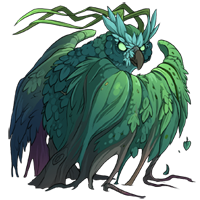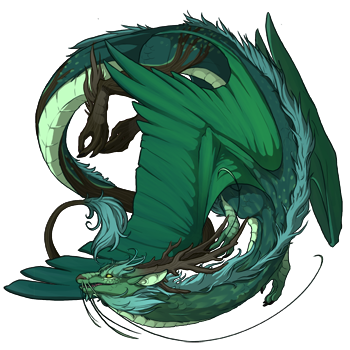

WildwoodOwl
(#91665131)
Level 1 Imperial
Click or tap to view this dragon in Predict Morphology.
Energy: 50/50

Expand the dragon details section.
Collapse the dragon details section.
Personal Style
Apparel
Skin

Scene
Measurements
Length
28.94 m
Wingspan
23.35 m
Weight
6523.89 kg
Genetics
Raspberry
Swirl
Swirl
Cream
Constellation
Constellation
Charcoal
Glowtail
Glowtail
Hatchday
Breed
Eye Type
Level 1 Imperial
EXP: 0 / 245


STR
6
AGI
6
DEF
6
QCK
5
INT
8
VIT
8
MND
6
Biography
Wildwood Owl


|
The Wildwood Owl is a large owl with green plumage that is a part of the true owl family. Wildwood Owls are native to forested regions, and most commonly found in the Viridian Labyrinth. Wildwood Owls are closely related to the Sakura Owls and are suspected to be related to Great Horned Owls. Description Unlike most birds, Wildwood Owls get their feathers' coloration from pigments. Similar to the Turaco, Wildwood owls produce turacoverdin, a green pigment that provides the coloration. It is believed the reason the owl's have pigment coloration is due to the fact that structural coloration leads to a glossy appearance. The Wildwood Owl's feathers are well adapted to work as camouflage. The feathers are colored in a variety of green shades, some feathers also look similar to leaves, most commonly that of oak leaves. These oak shaped feathers are mainly seen on the wings, but can be present on the body. Depending on the subspecies of the owl, the "leaf feathers" may look like another type of leaf, such as birch, elm, maple, etc. Near the top of the wings, a unique type of long feathers grow, similar in appearance to vines. These feathers are believed to help obscure the owl's outline and provide more camouflage. Due to the shape of these feathers and where they grow, they do not work as flight feathers. Due to this, Wildwood Owls have webbed wings, similar to bat wings, although delicate the wings do work to aid in flight. The facial disk of Wildwood owl has lightly colored feathers growing in an X-shape. These feathers are larger in comparison to the other feathers on the body. Some of these feathers grow above the head, giving the owl a set of "horns". Behind these feather horns are a set of three long feathers similar to the ones on the wings. Similar to the wing feathers, it is believed that these feathers also obscure the owl's outline. In many cases, two of these feathers grow behind the left "horn" while one grows on the right side. |
 Element Neutral Conservation Status Least Concern Scientific Classification Domain: Eukaryota Kingdom: Animalia Phylum: Chordata Class: Aves Order: Strigiformes Family: Strigidae Genus: Bubo Species: ???
Range
Viridian Labyrinth - All Year |
|
Diet Wildwood Owls are carnivorous and primarily eat small mammals, birds, and occasionally dragons. The owls tend to hunt in areas where their prey tend to pass through. This allows the owl to hide in the trees using their camouflage in order to get the jump on their prey. During the breeding season, Wildwood owls will attempt to hunt young from other animals. And in some cases, the owl will stake out near the nest site in order to steal the young when the parents leave. Interactions with Dragons Due to their habitat, Wildwood Owl's commonly encounter dragons. In many cases, the owls attack due to perceiving the dragons as a threat to themselves or their offspring. Due to this, it is advised to avoid areas with the owls, especially during mating season. In some cases, Wildwood Owls nest near nature dragon clans, causing frequent attacks until the owl is moved away from the clan. Relations with Dragons Due to their unique plumage, Wildwood owls are a common familiar for bird fanciers. In some cases, fanciers breed the owls in order to get unique leaf feathers. Though uncommon, Wildwood Owls are used in falconry due to their abundance. |
The long feathers of Wildwood Owls have evolved to appear similar to Wildwood Moss. A young Wildwood Owl, the feathers have yet to gain their characteristic leaf like shape. |
Click or tap a food type to individually feed this dragon only. The other dragons in your lair will not have their energy replenished.
Feed this dragon Insects.
Feed this dragon Meat.
Feed this dragon Seafood.
Feed this dragon Plants.
Exalting WildwoodOwl to the service of the Plaguebringer will remove them from your lair forever. They will leave behind a small sum of riches that they have accumulated. This action is irreversible.
Do you wish to continue?
- Names must be longer than 2 characters.
- Names must be no longer than 16 characters.
- Names can only contain letters.
- Names must be no longer than 16 characters.
- Names can only contain letters.













